1920s Flagpole Sitting: The Legacy of Alvin “Shipwreck” Kelly
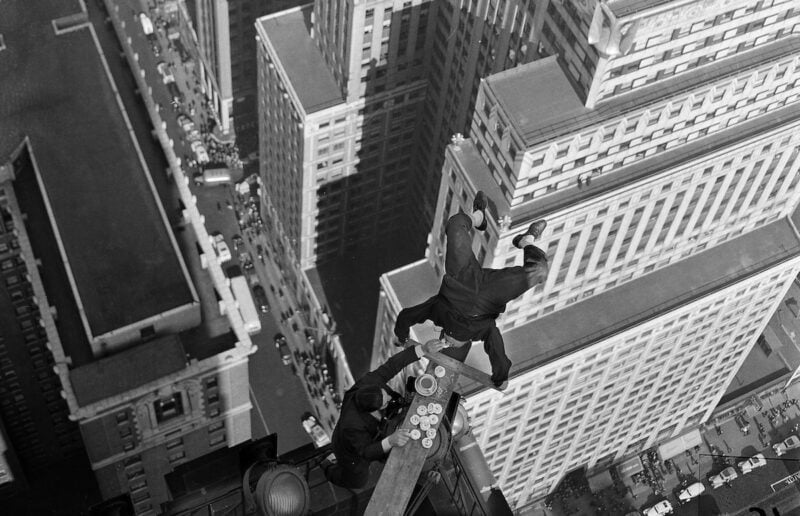
Alvin “Shipwreck” Kelly performs an upside-down flagpole sitting atop the Chanin Building in New York City. (AP Photo)
Updated August 14, 2024
July 2, 2020 ~ By Shari Rose
In the 1920s, flagpole sitting became a national obsession as Alvin “Shipwreck” Kelly performed incredible feats of endurance while perched atop skyscrapers
Alvin “Shipwreck” Kelly, a prolific flagpole sitter who first popularized pole sitting in the United States, attracted massive crowds and sparked national interest in the peculiar trend throughout the 1920s. But what is flagpole sitting exactly? Its goal is simple: Remain atop a pole for as long as possible. Pole sitters are allowed a seat, but they cannot touch the ground for any reason. Thousands of spectators watched Shipwreck Kelly wherever he performed his flagpole sitting stunts, marveling at the man who sat hundreds of feet above them for days, even weeks, at a time.
- Alvin Kelly Shows Early Interest in Dangerous Stunts
- Shipwreck Kelly Popularizes Flagpole Sitting in the 1920s
- How Shipwreck Kelly Stayed Atop Flagpoles for Days
- American Kids Pursue Pole Sitting
- Flagpole Sitting Loses Popularity During the Great Depression
- Death & Legacy of Alvin Kelly
Alvin Kelly Shows Early Interest in Dangerous Stunts
Aloysius Anthony Kelly was born in Hell’s Kitchen, New York on May 11, 1893. Kelly’s father had died before he was born, and his mother died in childbirth. Adopted and raised by a family friend, Kelly showed an early talent for daring stunts, climbing his first pole at seven years old and performing a “human fly” stunt on the side of a building two years later.
Kelly ran away from home at age 13 and changed his name to Alvin. The teenager became a merchant sailor, joining a ship’s crew and beginning his life at sea. Over the next 15 years, he chose to work in a wide range of risky professions, gravitating toward jobs that others would not take. Alvin Kelly worked as a steeplejack, high diver, boxer, and a stunt pilot known for performing daring aerial stunts.
During World War I, Kelly served in the Naval Auxiliary Reserve, and was discharged from service after three years. Much of Kelly’s life before his flagpole sitting stunts is unknown, including how he received the nickname, “Shipwreck.” In one interview, Kelly said he got his nickname from surviving multiple shipwrecks, plane crashes and car accidents, but there is little evidence to support. Some accounts say he got the name from being knocked out so many times as a boxer, though others contend that he received that name from surviving the sinking of the Titanic.
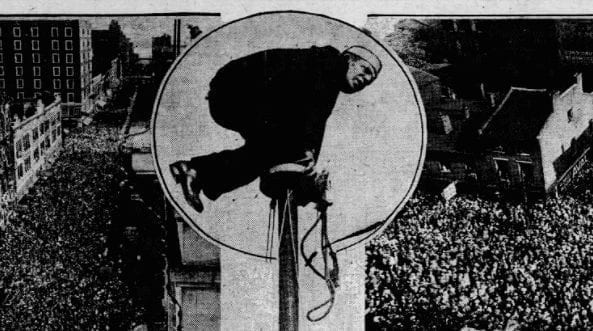
Alvin “Shipwreck” Kelly kneels on his flagpole perch while performing in Louisville in 1928. (Source)
It’s also not entirely known why Kelly climbed that first flagpole in 1924. A popular story says he was hired by a theater owner while working as a Hollywood stuntman to attract publicity by staying put atop the building’s flagpole for as long as he could. He sat on top of his flagpole for 13 hours and 13 minutes, and attracted a lot of public attention in the process. Word quickly spread in Hollywood about a man named Shipwreck Kelly and his pole sitting stunts.
Shipwreck Kelly Popularizes Flagpole Sitting in the 1920s
After the Hollywood stunt, Shipwreck Kelly began to attract fans with every successful flagpole sitting. Throughout the rest of the 1920s, he toured 28 cities across the United States, sitting atop poles in each city to the delight of spectators. By charging admission for up-close viewings of himself on the flagpole, as well as the opportunity to speak with him briefly, Kelly’s personal income skyrocketed.
Local businesses, such as theaters and department stores, sponsored him for advertising purposes. Multiple books were written about Shipwreck Kelly. At one point, he was paid $100 an hour for his flagpole sitting stunts.
- More stories: Hatpin Panic: How Pins Upended 20th Century Gender Politics
- More stories: The Mayhem of Hell-Cat Maggie in New York City
During one of his sittings, Kelly met a elevator operator named Frances Vivian Steele, who wanted to shake hands with him. They fell in love, married, and had one son together.
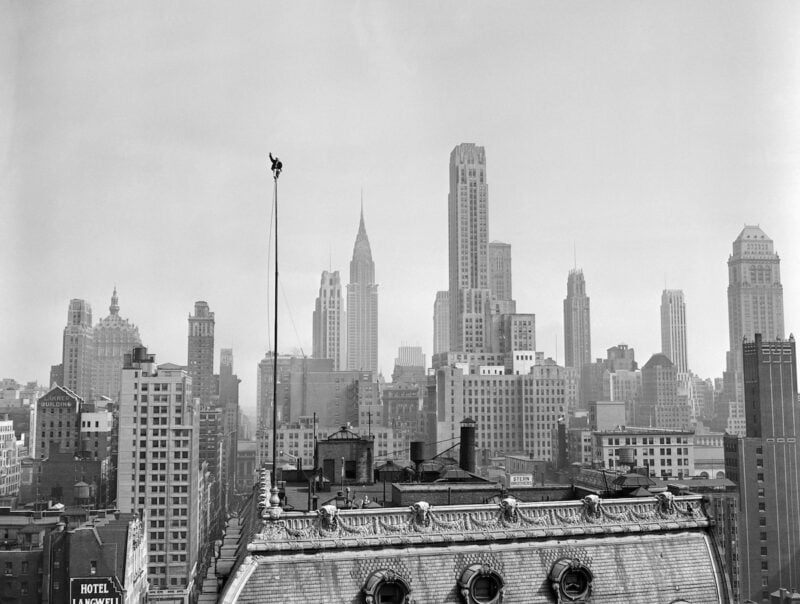
Alvin “Shipwreck” Kelly sits at the top of a 65-foot flagpole on the 15-story Times Square hotel in New York City in 1939. (AP Photo)
Some of Shipwreck Kelly’s famous pole sittings include:
- New Orleans, LA – 80 hours: Kelly performed a flagpole sitting on top of the Jung Hotel on Canal Street in March 1928. He was aiming for 100 hours, but severe weather forced him to retire after 80.
- Kansas City, MO – 146 hours: Kelly stayed atop a flagpole on Kansas City’s Westgate Hotel for more than six days in February 1927. Temperatures were said to have dropped to 17 degrees Fahrenheit. After the stunt, Kelly said, “There was rain and snow and smoke from the railroads. That’s one week I won’t forget.”
- St. Louis, MO – 169 hours: In 1926, Kelly remained perched for seven days and one hour, setting a new world record.
- Newark, NJ – 312 hours: In 1927, he sat atop a flagpole on the St. Francis Hotel building in Newark for 13 days.
- Baltimore, MD – 559 hours: Kelly performed a pole sitting in Carlin’s Park in 1929, which lasted 23 days and seven hours.
- Atlantic City – 1,177 hours: In his longest flagpole sitting feat, Shipwreck Kelly remained perched on the Steel Pier’s flagpole, more than 200 feet in the air, for 49 days and one hour. His record, achieved in 1930, remains the modern-day record. It’s estimated that more than 20,000 people flooded the streets to watch him.
How Shipwreck Kelly Stayed Atop Flagpoles for Days
Kelly’s small perch atop flagpoles offered few comforts. He sat on a cushioned seat, about 13 inches wide. He fashioned rope stirrups for his feet to keep his balance and protect him from falling off. Kelly did not sleep at night, but rather took quick, five-minute naps throughout the pole sitting.
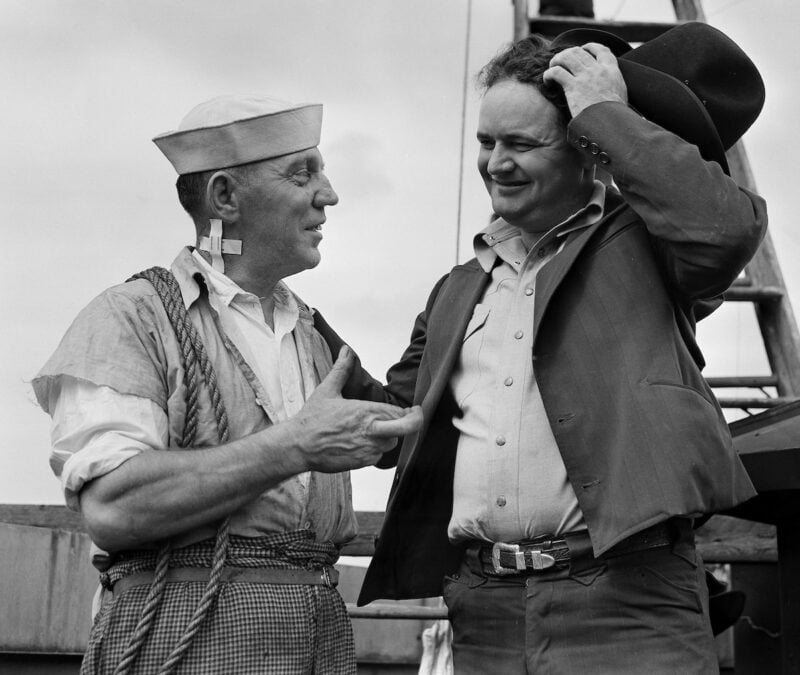
Alvin “Shipwreck” Kelly, left, speaks with Faye Hubbard, a Spokane-based rancher, in New York on Sept. 30, 1939. Kelly bet Hubbard $250 that he could perch for eight days and nights on a Manhattan flagpole, but after four hours on his perch, police decided the spectacle was causing a traffic jam and persuaded him to come down. (AP Photo)
During his flagpole sitting stunts, Kelly did not eat solid food, relying on a diet of mostly broth, coffee, and cigarettes. Like the humorous example of the pole skater in John Steinbeck’s Cannery Row, a burning question in the minds of the public was how exactly Kelly relieved himself during the sittings. It’s believed that he discreetly placed a tube that carried bodily waste down the pole and into a receptacle on the ground.
- More stories: Esther Jones: Betty Boop’s Original Influence
- More stories: Gallus Mag: New York’s Most Brutal Bouncer in 1860s
American Kids Pursue Pole Sitting
After Shipwreck Kelly’s flagpole sitting in Baltimore, children and teens in the city followed suit. Strange thought it may seem, flagpole sitting became especially popular among America’s youth as children competed for new records and local notoriety in their hometowns. A 15-year-old named Avon Foreman sat on a flagpole for 10 days, 10 hours, and 10 seconds. Baltimore mayor William Frederick Boening sent Foreman a letter after his feat, praising his determination and suggesting that pole sitting embraced “old pioneer spirit of early America.”
In a letter to the editor, a local citizen commended Foreman’s pole sitting stunt: “He had shown the indomitable spirit and courage of a real Christian youth, like the Crusaders of old, and I was proud to be there to applaud. It is from such boys great missionaries are made.”

Baltimore flagpole sitters Avon Foreman and Ruth McCruden in 1929. (Source)
Not unlike the planking fad of 2010, other young people hopped aboard the trend and attempted their own flagpole sittings in the 1920s. Ruth McCruden, a 10-year-old in Baltimore, remained atop her flagpole for 14 days. McCruden proudly said she would “show the world and a few of her uppish boy friends what a girl can do.”
Mayor Boeing spoke with her as well, though his words were substantially less encouraging. He said to McCruden, “If you get lonely up there, get some of your boy friends to come up and keep you company.”
McCruden responded simply, telling the mayor: “All right.”
Despite the exploding popularity of flagpole sitting, some older generations voiced their displeasure with the young peoples’ new fad. One person wrote into the Baltimore Evening Sun to share their disdain with the editor: “I certainly think the mayor of our city could find a more beneficial way of spending his time. Let the neighbors and kids make all the ‘whoopee’ over him they like, but when it comes to city officials wasting their time on such nonsense, I think someone should protest.”
Flagpole Sitting Loses Popularity During the Great Depression
Adored by crowds of thousands, Shipwreck Kelly’s reign as the most famous flagpole sitter in America started to fade. The stock market crash of 1929 and resulting Great Depression flipped national attitudes on daredevil entertainment, and the spectacle of pole sitting lost its allure. The country’s infatuation with Shipwreck Kelly waned as the economic depression deepened and realities of a global recession took hold.
In ensuing years, Kelly was widely viewed as a public nuisance by both local residents and police. In 1935, he attempted a flagpole sitting in the Bronx to break his Atlantic City record, but was stopped after less than a day by police.
- More stories: The Triumphs of Edward Gardner at the 1928 Bunion Derby
- More stories: Lucy Hicks Anderson: Black Transgender Pioneer of the 1940s
Making a drastic career change like he had so many times before, Kelly began working as a gigolo in a Broadway dance hall. He still occasionally performed pole sitting on the side, itching for the next big stunt.
On Friday the 13th in 1939, Dunkin’ Donuts sponsored Shipwreck Kelly to perform a stunt on the Chanin building in New York to mark National Doughnut Week. In one of his last widely publicized stunts, he was photographed eating doughnuts upside-down while doing headstands on a wooden plank sticking out the side of the 54th floor.

Alvin “Shipwreck” Kelly puts his pole sitting act in reverse and dunks doughnuts on the Chanin Building in New York on Oct. 13, 1939. Kelly dunked 13 doughnuts while performing a handstand on the pole, with the assistance of a helper. (AP Photo)
After that sitting, Kelly returned to a life at sea and became a merchant marine, eventually serving during WWII. After the war, he was destitute and relied on public services for survival.
Death & Legacy of Alvin Kelly
Kelly performed his final flagpole sitting in early October 1952 in Orange, TX. While sitting on a 65-foot pole, he suffered multiple heart attacks and officially retired, publicly announcing he was finished with flagpole sitting.
Walking down the street in Hell’s Kitchen, the neighborhood where he grew up, Alvin “Shipwreck” Kelly collapsed and died on October 11, 1952. He was holding a book that contained more than 13,000 hours of flagpole sitting he performed during his career.
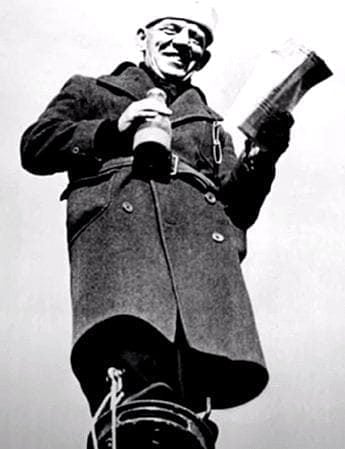
Shipwreck Kelly performs one of his last flagpole sittings in 1942 in College Park, MD. (Wikimedia Commons)
At the time of his death, Kelly’s wife had already passed away and his son, Alvin Jr., was serving overseas, so his body lay unclaimed in the morgue. Alvin Kelly was eventually buried at Long Island National Cemetery.
Though some attempted to bring back the trend of flagpole sitting in the 1960s and 1970s, it never gained steam like it had in the past. This national craze remains preserved as one of the more peculiar, outrageous, and forgotten trends of the 1920s, led by the daredevil trailblazer himself, Alvin “Shipwreck” Kelly.
- More stories: Legend of Sadie the Goat in New York City
- More stories: The Forgotten Anti-Filipino Watsonville Riots of 1930







0 Comments